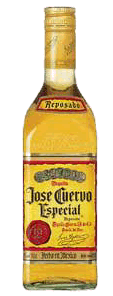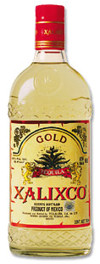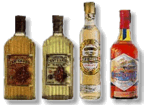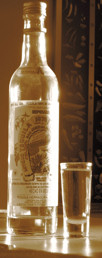Pure agave and mixto tequilas
Premium brands: 100% agave
 For aficionados, the most important identifier on the label
of a tequila bottle is "100% agave" or
"100% agave azul" - cien por ciento de agave azul. This means it is made only
from the blue agave plant, with only agave sugars used for fermentation, and was
approved by a government inspector to ensure purity.
For aficionados, the most important identifier on the label
of a tequila bottle is "100% agave" or
"100% agave azul" - cien por ciento de agave azul. This means it is made only
from the blue agave plant, with only agave sugars used for fermentation, and was
approved by a government inspector to ensure purity.
100% agave means no other sugar was used during fermentation to create the
alcohol, so it has more body, more flavour, and a stronger agave aroma.
"100% agave" can make even a strong blanco tequila into a respectable drink,
with a peppery bite and a powerful agave-sharp tang.
 Caveat emptor: merely saying 100% agave does not guarantee quality: it's merely
the starting point. Each distillery has its own source of agave, its own
processes, quality control and techniques that will affect the final result.
While most producers create their products with considerable pride and effort,
others are merely average and their products reflect it. Only by tasting them
will you be able to decide for yourself.
Caveat emptor: merely saying 100% agave does not guarantee quality: it's merely
the starting point. Each distillery has its own source of agave, its own
processes, quality control and techniques that will affect the final result.
While most producers create their products with considerable pride and effort,
others are merely average and their products reflect it. Only by tasting them
will you be able to decide for yourself.
Small artisanal or boutique distilleries have sprung up, offering premium 100%
agave tequilas, but usually with limited (and therefore much sought-after)
production. Some, like Los Abuelos, pride themselves in keeping to the
traditional methods, including using a vintage tahona to crush the cooked agave
heads. For many economic and tax reasons, these premium products may only be
available outside Mexico.
Be sure to check the NOM - that will identify the factory where the tequila is
produced. many distillers today make tequila for more than one company.
Under new Mexican laws, premium mezcal must also be 100% agave.
Back to top
Mixto brands: additives and non-agave sugars
 If it doesn't say 100% agave, it's a mixto tequila. Mixtos are never labelled as mixto, but are merely called
"tequila." While most purists won't drink mixtos, many tequila
aficionados got their first taste from the popular mixto brands like Cuervo
Especial. So mixtos have played an important role in the journey to tequila
knowledge. Some bartenders only use mixtos for cocktails like margaritas,
claiming the other ingredients mask the taste of a better tequila. Again,
purists insist on 100% agave tequilas in their margaritas.
If it doesn't say 100% agave, it's a mixto tequila. Mixtos are never labelled as mixto, but are merely called
"tequila." While most purists won't drink mixtos, many tequila
aficionados got their first taste from the popular mixto brands like Cuervo
Especial. So mixtos have played an important role in the journey to tequila
knowledge. Some bartenders only use mixtos for cocktails like margaritas,
claiming the other ingredients mask the taste of a better tequila. Again,
purists insist on 100% agave tequilas in their margaritas.
There are more mixto brands than 100% agave brands, although that may change
in the future as drinkers become aware of, and demand more, pure tequila.
The decision to use non-agave sugars (usually cane sugars) in
fermentation along with those from the agave was made in the 1930s in
part because of this shortage, a
fateful move that changed the industry and affected its reputation for
decades. The official standard established in 1949 required that the
sugars in the beverage come 100% from blue agave, but by 1964 distillers were allowed to use 30% other sugars, which
soon climbed to 49%.The blander product, however, was more palatable to
American tastes and helped boost export sales.
Mixto tequilas can legally be made with alcohol fermented from other (non-agave) sugars,
up to 49% (meaning they must be made with at least 51% agave sugars). Allegedly the amount of agave
sugars required was supposed to have been increased in 1995 from 51% to 60%, but
this never happened and is not mentioned in the 2005 NORMA.
Even when it is more expensive per kilogram than raw agave, it is less expensive
to make tequila with cane sugar than 100% agave sugar. That's because the agave
requires more work - harvesting, cooking, milling - to produce its fermentable
sugars.
 Some companies are experimenting with improved mixtos, using more agave sugars,
and less can sugars. For example, 4 Copas has a mixto called "Dos Amores" with
70% agave sugars. Their goal is to improve the mixto experience for new
consumers to encourage them to upgrade to 100% agave tequilas. A similar mixto,
Casco Viejo, from Tequila Supremo, is also 70-30. With the current
(2007) glut of agave in the fields, there are many opportunities for tequila
makers to pursue better mixtos like this, but very few have taken the step
forward.
Some companies are experimenting with improved mixtos, using more agave sugars,
and less can sugars. For example, 4 Copas has a mixto called "Dos Amores" with
70% agave sugars. Their goal is to improve the mixto experience for new
consumers to encourage them to upgrade to 100% agave tequilas. A similar mixto,
Casco Viejo, from Tequila Supremo, is also 70-30. With the current
(2007) glut of agave in the fields, there are many opportunities for tequila
makers to pursue better mixtos like this, but very few have taken the step
forward.
Mixtos may be aged like 100% agave tequilas. It is becoming more common to see
labels like reposado and even aņejo on mixtos, which can confuse the consumer
who assumes only 100% agave tequilas are aged. Look for the declaration of 100%
agave to be sure.
Cold mixing - adding alcohol to the tank after the agave sugars are fermented - is not permitted.
All the sugars must be fermented at the same time.
Rather curiously, the other sugars used in mixto tequilas are not permitted to
be sugars from any species of
agave. So it's illegal to use, say, espadin agave (used for making mezcal) in mixto tequila. The 51%
agave sugars
required for mixtos have to be the only agave sugars, and can only come from the tequilana weber blue
variety agave grown in the territory specified by Mexican law. Generally, cane
sugars are used in the fermentation process to produce much of the alcohol in mixtos- but none of the taste of 100% agave.
Some people believe that better mixtos may be created by using other agave
sugars, but it might also weaken the separation between pure tequilas and
mixtos.
Some mixtos also have added are sugar,
caramel and almond essence to make them appear gold - and aged. Even with these
additives, a mixto can still be called 'tequila.'
Mixto tequilas may also be bottled outside Mexico. While most bottlers do not
adulterate the bulk tequila, they do not have to live up to
the same standards in the bottling nation as are present in Mexico. Without the oversight of the Mexican Tequila Regulatory Council,
there are concerns the bulk tequila may be diluted or altered at the bottler.
Legally, mixtos can contain one or more of the following ingredients:
- Caramel coloring
- Natural oak or Encino oak extract (holm or holm oak extract).
- Glycerin
- Sugar-based syrup
 All those non-agave ingredients are also part of the recipe for a hangover (as
are the congeners in alcohol).
All those non-agave ingredients are also part of the recipe for a hangover (as
are the congeners in alcohol).
In general, 100% agave means better quality, flavour, taste and purity,
fewer congeners, no additives -
and a lower chance of a hangover.
Mixtos can be aged - there's no law against it. But most companies don't go to
the effort or expense, especially given the estimate that 70% of all tequila
sold in the USA is used in margaritas. Why make a better mixto when it will be
lost in a cocktail? Well,
Sauza's Conmemorativo is a mixto
aged long enough to be called aņejo, and proves a mixto blend can be well-made. This
brand is frequently the tequila of choice in margaritas in Mexico's popular vacation
zones.
 As reported by Morris Thompson (Knight Ridder News Service, Feb. 7, 2001),
the previous agave shortage encouraged many producers to change some of their
brands from 100% to mixto, including one brand previously popular among
Mexicans:
As reported by Morris Thompson (Knight Ridder News Service, Feb. 7, 2001),
the previous agave shortage encouraged many producers to change some of their
brands from 100% to mixto, including one brand previously popular among
Mexicans:
"Ramon Valdes, president of Tequila Herradura, S.A. de C.V., Mexico's
second-oldest commercial tequila distiller, is not happy. His firm came in
for criticism recently after a reporter noticed that the label on its El
Jimador brand now says just 'tequila.' It used to be 100% agave.
"Valdes says his company made the change in El Jimador's formula last
May. Otherwise, he said, his firm would have had to double El Jimador's
price, about $13 a bottle in Mexico, because agave prices have risen 3,000% since 1995. That's when U.S. demand started to surge, and just as it
did, a freeze and disease cut agave crops sharply.
Premium brands that have changed their formulas - and labeling - include
100 Aņos, La Querencia, Tahona, Puente Viejo, Corralejo, Jornalero and
Quita Pensas."
Since the shortage, many of these companies have returned to making 100%
agave tequila, so if you stopped drinking a formerly favourite brand because
it became a mixto during this period, check the label again. It may be back
on the shelf as a 100% agave tequila.
Back to top
Who drinks which?
 One estimate suggests 70% of all tequila consumed in the USA is used in
margaritas. The highest volume of sales in in mixtos, so it's obvious
consumers still purchase a lot of mixto, even when there is a growing number
of pure tequilas on the shelf beside them. That's in part because of a
popular notion that it's a waste to use premium tequilas in margaritas or
other mixed drinks. It isn't: 100% agave tequilas make better margaritas.
One estimate suggests 70% of all tequila consumed in the USA is used in
margaritas. The highest volume of sales in in mixtos, so it's obvious
consumers still purchase a lot of mixto, even when there is a growing number
of pure tequilas on the shelf beside them. That's in part because of a
popular notion that it's a waste to use premium tequilas in margaritas or
other mixed drinks. It isn't: 100% agave tequilas make better margaritas.
Tequila tastes are changing rapidly in Mexico and apparently becoming more
sophisticated than most tequila drinkers outside of the country. Mexicans
consume the greatest volume of pure tequilas, but that is slowly changing
due in great part to the expanding American market and the increasing number
of aficionados outside Mexico.
Premium (100% agave) tequilas are the hottest segment of the market in the
USA today and one study estimates the US will consume the majority of the
tequila production, even more than Mexico, by 2010.
 Many US and
Canadian tequila drinkers simply haven't changed because they are used to mixto
brands, or cannot get many 100% agave tequilas in their area and those
available are expensive. In Asia,
Europe, Ukraine and Russia, most tequilas are mixtos.
Many US and
Canadian tequila drinkers simply haven't changed because they are used to mixto
brands, or cannot get many 100% agave tequilas in their area and those
available are expensive. In Asia,
Europe, Ukraine and Russia, most tequilas are mixtos.
Most margaritas in bars and resorts are made from mixto tequilas, although
some upscale bars may offer 100% agave instead (at a higher price). And
unfortunately many tourists who visit Mexico, especially in the party resort
locations like Cancun are fed the cheap mixtos and seldom know enough to ask
for something better.
 In 1995, 100% agave tequilas represented only 15% of the
entire production. By the end of 1998, they had grown to 35%. By
2006, it was more than 34% of production.
In 1995, 100% agave tequilas represented only 15% of the
entire production. By the end of 1998, they had grown to 35%. By
2006, it was more than 34% of production.
In 2006, the total production of tequila was 228,226,209 litres, of which
77,745,302 were 100% agave. In the first five months of 2007, production of
100% agave tequilas represented more than 46% of the total production. So
the trend is clearly towards 100% agave tequilas and away from mixtos. The
consumer is becoming more educated and sophisticated.
This is also accompanied by an increase in cost to the consumer, so the
trend will likely hit a resistance point in many countries where the extra
cost is not perceived to be worth the product. Premium products always have
a market, however, if for nothing more than their status appeal. Already the
rising cost of tequila has pushed it outside the range of most average
Mexicans.
Generally, the new flavoured tequilas
and tequila-juice infusions use a mixto, but not always. Check the
label.
Back to top


